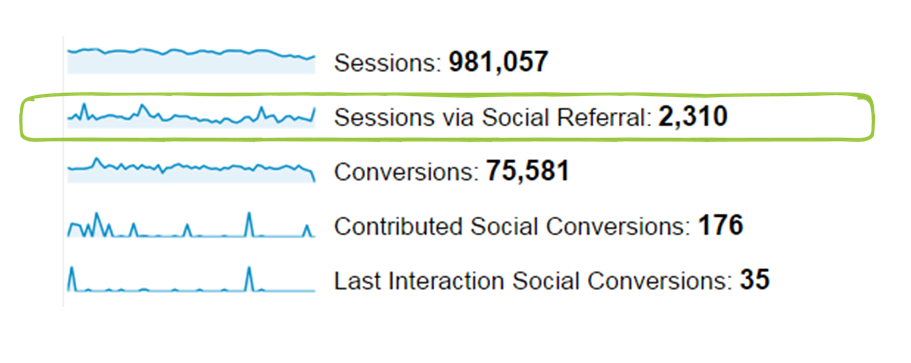Marketers know social media strategies are an indispensable way to:
1. Drive traffic to your website
2. Engage qualified customers
3. Convert those customers
Don’t have goals you say? Use this article to help determine what you’re attempting to achieve on social media and the best way to go about pursuing it!
While the potential benefits are common knowledge, there’s an information gap around measurement. How do you connect the dots between your success on social networks and your online marketing goals? How do you make sure your success on social media is spilling over to your website, where people can learn more about your business and buy from you?
The hard truth is: If you’re not paying attention to certain metrics in your social media reports, you won’t be effective. The only way you’ll know if your approach is successful is if you know which metrics to check.
Here is a breakdown of the numbers you should be tracking to measure your social media marketing, whether your business is striving to excel at one of these goals or trying to ramp up efforts on all fronts:
First, check your traffic
All marketing endeavors share one common end-goal: Making money. And the best way to increase revenue through social media is to drive buyers to your website.
Website traffic is a strong testament to whether your social media efforts are hitting home with your target audience.
In terms of specific Google Analytics metrics to determine your social traffic, look for sessions coming from social referrals.
1. Sessions via Social Referral: A session that you see in a Google analytics report is the “period of time a user is actively engaged with your website.”
Social referral sessions are the number of times users were directed to your website through social media. If you think about your website as a brick and mortar store, this is the number of times that social media got a potential customer to walk in the door and browse around. Once they’re in the store, it takes things like product displays and customer service to land a sale.
Social media’s job here is to clear the path to get people inside.

Then, confirm social engagement brings in qualified visitors
Once a prospect is on your site, you want to make sure they’re engaged. An engaged visitor spends more time on the site, reads your content and learns about your business. Engaged customers are the ones who will become your customers.
In a world of clickbait, it’s important to make sure your most popular social posts are bringing in qualified visitors who are genuinely interested in learning about your business. Getting 100 Likes on a post certainly looks good – and it can boost your brand awareness – but it won’t help your bottom line if those visitors all bounce away, or don’t visit your site at all.
To measure how social engagement turns into on-site interest, check for metrics like Pageviews and Session Duration.
2. Pageviews: Pageviews are pretty straightforward. It’s the number of pages that someone looked at while on your website after they arrived from a social media channel.
Google Analytics breaks it down by network so you can pinpoint which networks are getting visitors to click around more than others. These are the sources of your most engaged traffic, where you should share high-value information.
3. Average Session Duration: The average session duration is the amount of time that someone spends on your website after landing from a social engagement.

This is important because it provides insights into which networks are getting your audience to visit, but also digest your content. Look for the networks driving engaged readers. These are the networks attracting an audience that’s most likely to convert, where you should share lower-funnel content that nurtures interest in your products and services.
4. Landing pages visits: Look at the specific landing pages that people are visiting, and the subsequent activities on those pages.
If your audience interacts with pages that have downloadable resources, but not videos – you should focus on sharing long-form educational resources. If visitors engage with infographics over list-articles, you should include more visual content in your social posts.
Remember that every company’s social strategy is different. While sharing blog posts might work best for one company, white papers and infographics work for another. Pay attention to the metrics if you want the most successful social media strategy.
Finally, convert those visitors
At the end of the day, most marketers want to win conversions from any strategy, social media included. It’s important to understand that unless you sell small-ticket items directly to consumers, you might not see a lot of one-to-one sales from your social posts. That’s completely normal, and more importantly, it doesn’t mean your strategy is ineffective.

Rather, social media marketing is a long-game about nurturing interest, entertaining and educating prospects until they can’t resist anymore and they decide to buy from you. Here’s how you can tell you’re generating those conversions at the end of the day:
5. Contributed Social Conversions: A conversion is when a website visitor completes an action you’ve predefined – something that provides value to your business.
It might be a sale, it might be be a demo request or it might be a completed formfill with contact information. No matter the form, contributed social conversions are instances when someone who came to your website via social media took an action that contributes to a sales opportunity.
6. Last-interaction social conversion: The last interaction social conversion is when social media was the last link in the chain that resulted in a website visitor getting qualified as a customer.
This means someone came to your site from social and then converted. It suggests a Tweet or Facebook Post was the final push they needed to head straight to your site and complete a transaction.
There’s a wealth of information in Google Analytics reports – if you know how to find it AND understand what it means for your social strategy. It’s one thing to look at reports and see numbers are referral traffic, but you need to connect the dots behind those numbers. How does an increase in referral traffic tie back to your recent strategy – have you been promoting specific assets or product categories that are resonating with followers?
That’s where a social media strategist comes in. It’s helpful to have someone who knows how to interpret Google Analytics metrics and use them to direct your social media strategy. This is how the most successful companies get the most out of their investments in different networks.





